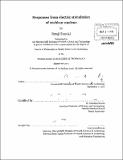Responses from electric stimulation of cochlear nucleus
Author(s)
Suzuki, Ryuji, Ph. D. Massachusetts Institute of Technology
DownloadFull printable version (7.495Mb)
Alternative title
Responses from electric stimulation of CN
Other Contributors
Harvard University--MIT Division of Health Sciences and Technology.
Advisor
M. Christian Brown.
Terms of use
Metadata
Show full item recordAbstract
Cochlear nucleus (CN), the exclusive destination of the auditory nerve, is the gateway for all central processing of auditory information. The CN comprises three major subdivisions: anteroventral, posteroventral and dorsal (AVCN, PVCN and DCN, respectively), each of which contains anatomically and physiologically distinct neurons projecting onto different targets. This research used focal electric stimulation of small, confined parts of the CN in anesthetized guinea pigs to resolve the roles of the CN divisions, in two contexts. Part i explored the effect of stimulation on the gross neural potential (electrically evoked auditory brainstem response, EABR). In AVCN and PVCN away from the 8th nerve fibers entering the brainstem, stimulation consistently evoked waveforms comprising 3 waves, suggesting a diffuse distribution of cellular generator of the EABR. On the other hand, in vestibular structures (vestibular nerve root and Scarpa's ganglion), the characteristic waveform comprised only two waves. Stimulation of multiple neural structures, as seen with higher stimulus levels or stimulation in auditory nerve root area generally produced more complex and variable waveforms. Part 2 explored the effects of stimulation on the activation of one type of auditory reflex, medial olivocochlear (MOC) reflex. The reflex was monitored through its effects on distortion product otoacoustic emission (DPOAE). The MOC reflex was activated bilaterally by stimulating PVCN or AVCN shell, but not AVCN core. These results suggest that there are two groups of MOC interneurons in specific parts of CN.
Description
Thesis (Ph. D.)--Harvard-MIT Division of Health Sciences and Technology, 2010. Cataloged from PDF version of thesis. Includes bibliographical references.
Date issued
2010Department
Harvard University--MIT Division of Health Sciences and TechnologyPublisher
Massachusetts Institute of Technology
Keywords
Harvard University--MIT Division of Health Sciences and Technology.